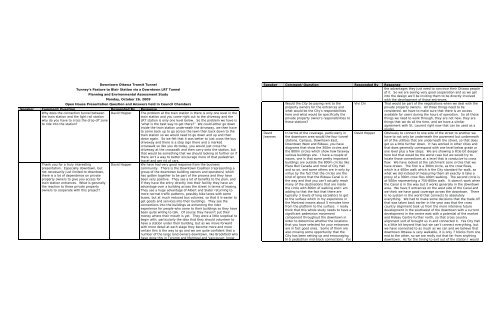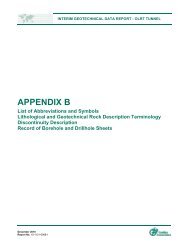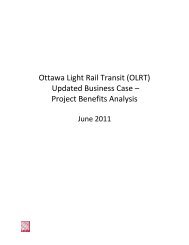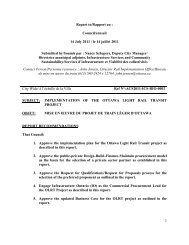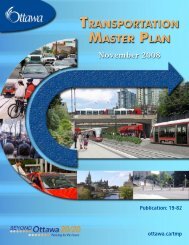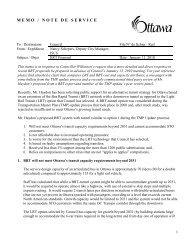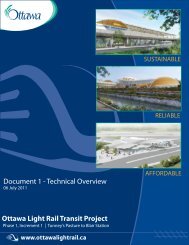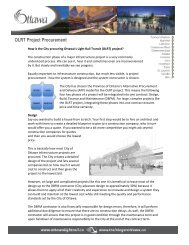Appendix A_Pages266to338_9MB.pdf - Ottawa Confederation Line
Appendix A_Pages266to338_9MB.pdf - Ottawa Confederation Line
Appendix A_Pages266to338_9MB.pdf - Ottawa Confederation Line
You also want an ePaper? Increase the reach of your titles
YUMPU automatically turns print PDFs into web optimized ePapers that Google loves.
Downtown <strong>Ottawa</strong> Transit Tunnel<br />
Tunney’s Pasture to Blair Station via a Downtown LRT Tunnel<br />
Planning and Environmental Assessment Study<br />
Monday, October 26, 2009<br />
Open House Presentation Question and Answers held in Council Chambers<br />
Speaker Comment/Question Responded By Response<br />
Why does the connection tunnel between<br />
the train station and the light rail station<br />
why do you have to cross the drop off zone<br />
to ride into the station?<br />
David Hopper The problem at the train station is there is only one level in the<br />
train station and you come right out to the driveway and the<br />
LRT station is only one level below. So the problem we have is<br />
“what is the best way to get there?” We could either go down<br />
inside the train station underneath the driveway, we then have<br />
to come back up to go across the lawn then back down to the<br />
train station so we would need to go down and up and then<br />
down again. So we felt that it was better to just cross the bus<br />
driveway and there is a stop sign there and a marked<br />
crosswalk so like you do today, you would just cross the<br />
driveway at the crosswalk and then carry onto the station, but<br />
that would be something that we should looking at further on if<br />
there isn’t a way to better encourage more of that pedestrian<br />
travel and get rid of cars.<br />
Thank you for a truly interesting<br />
presentation. Especially downtown, but<br />
not necessarily just limited to downtown,<br />
there is a lot of dependence on private<br />
property owners to give you access for<br />
train station entrances. What is generally<br />
the reaction to these private property<br />
owners to cooperate with this project?<br />
David Hopper<br />
We have had very good response from the business<br />
community. There is the Downtown Coalition (representing a<br />
group of the downtown building owners and operators) which<br />
has gotten together to be part of the process and they have<br />
been very positive. They see a lot of benefits to the plan, and<br />
if they have the entry directly into their facility they have an<br />
advantage over a building across the street in terms of leasing.<br />
They see a huge advantage of Albert and Slater returning to<br />
more normal traffic patterns, possibly bike lanes with some<br />
buses, but at much reduced bus volumes, so that it is easier to<br />
get goods and services into their buildings. They see the<br />
connections into the buildings as enhancing the rider<br />
experience for people who come to their buildings so they have<br />
been quite willing to talk. Of course they haven’t put their<br />
money where their mouth is yet. They were a little sceptical to<br />
begin with, particularly the idea that they should volunteer to<br />
have a station under their building, but as we move forward<br />
with more detail at each stage they become more and more<br />
certain this is the way to go and we are quite confident that a<br />
number of the large land owners downtown, like Brookfield who<br />
have done this in Toronto and Montreal and Vancouver, know<br />
Speaker Comment/Question Responded By Response<br />
the advantages they just need to convince their <strong>Ottawa</strong> people<br />
of it. So we are seeing very good cooperation and as we get<br />
into the design we’ll be inviting them to be directly involved<br />
with the development of those entrances.<br />
David<br />
Jeannes<br />
Would the City be paying rent to the<br />
property owners for the entrances and<br />
what would be the City’s responsibilities<br />
here and what would be specifically the<br />
private property owner’s responsibilities to<br />
these stations?<br />
In terms of the coverage, particularly in<br />
the downtown area would the four tunnel<br />
stations, Campus, Downtown East,<br />
Downtown West and Rideau, you have<br />
diagrams that show the 300m circles and<br />
the 800m circles which show how faraway<br />
various buildings are. I have a couple of<br />
issues, one is that some pretty important<br />
buildings are outside the 800m circles like<br />
Place Bell Canada and most of City Hall<br />
and so on, and some others are in only by<br />
virtue by the fact that the circles are the<br />
kind of ignore that the Rideau Canal is in<br />
the way and that you can’t actually reach<br />
many of the destinations that are inside<br />
the circle with 800m of walking and I am<br />
adding to that the fact that there are<br />
typically 3 levels of long escalators to get<br />
to the surface which in my experience in<br />
the Montreal means about 5 minutes time<br />
from the platform to the surface. I really<br />
think that this whole study needs to have a<br />
significant pedestrian movement<br />
component throughout the downtown in<br />
order to determine whether the locations<br />
that you have selected for your entrances<br />
are in fact good ones. Some of them are<br />
also missing some opportunity that the<br />
City has been setting up and encouraging<br />
N-S pedestrian mid-block connections. For<br />
Vivi Chi<br />
David Hopper<br />
That would be part of the negotiations when we deal with the<br />
private property owners. All those things need to be<br />
considered, we have to make sure that there is an access<br />
available for users during the hours of operation. So all those<br />
things we need to work through, they are not new, they are<br />
things that we do all the time, and we have a similar<br />
agreement with St. Laurent right now that can be used as a<br />
model.<br />
Obviously to connect to one side of the street to another we<br />
have to not only be underneath the pavement but underneath<br />
all of the utilities that are underneath the street, so that does<br />
get us a little further down. It has worked in other cities and<br />
that does generally correspond with one level below grade or<br />
one level plus a few steps. We are showing a little bit deeper<br />
here but that would be the worst case but we would try to<br />
locate those connections at a level that is conducive to cross<br />
flow. We have looked at the catchment zone circles that we<br />
have drawn. The first is a 300m circle, as the crow flows,<br />
which is a 400m walk which is the City standard for walk, so<br />
what we did instead of measuring them all exactly is take a<br />
proxy of a 300m crow flies 400m walking. The second circle is<br />
at 500m representing a 750-800m walk. It doesn’t work when<br />
the Canal is in the way but it works generally in the downtown<br />
area. We have 5 entrances on the west side of the Canal and<br />
we think we have good coverage across the downtown. There<br />
is no system in the world that connects to absolutely<br />
everything. We had to make some decisions that the trade off<br />
that was taken back earlier in the year was that the cross<br />
country alignment took us from the more intensive future<br />
development in the southwest of the downtown with a current<br />
development in the centre east with a potential of the market<br />
and Rideau Centre further north, so that cross country<br />
alignment sort of brought us in and connected it. Yes City Hall<br />
is a little bit beyond that but we can’t connect everything, but<br />
we have connected to as much as we can and we believe that<br />
downtown <strong>Ottawa</strong> is very walkable, it is only 7 blocks from one<br />
end to the other, so we are really not that far from anything<br />
downtown. As for the timing to exit out of the station I would


